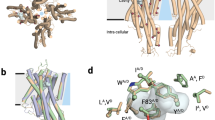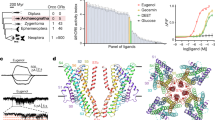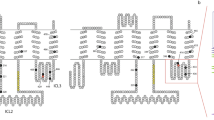Abstract
In insects, each olfactory sensory neuron expresses between one and three ligand-binding members of the olfactory receptor (OR) gene family, along with the highly conserved and broadly expressed Or83b co-receptor1,2,3,4,5,6,7,8,9. The functional insect OR consists of a heteromeric complex of unknown stoichiometry but comprising at least one variable odorant-binding subunit and one constant Or83b family subunit10,11,12,13,14,15,16. Insect ORs lack homology to G-protein-coupled chemosensory receptors in vertebrates17 and possess a distinct seven-transmembrane topology with the amino terminus located intracellularly10,18. Here we provide evidence that heteromeric insect ORs comprise a new class of ligand-activated non-selective cation channels. Heterologous cells expressing silkmoth, fruitfly or mosquito heteromeric OR complexes showed extracellular Ca2+influx and cation-non-selective ion conductance on stimulation with odorant. Odour-evoked OR currents are independent of known G-protein-coupled second messenger pathways. The fast response kinetics and OR-subunit-dependent K+ ion selectivity of the insect OR complex support the hypothesis that the complex between OR and Or83b itself confers channel activity. Direct evidence for odorant-gated channels was obtained by outside-out patch-clamp recording of Xenopus oocyte and HEK293T cell membranes expressing insect OR complexes. The ligand-gated ion channel formed by an insect OR complex seems to be the basis for a unique strategy that insects have acquired to respond to the olfactory environment.
This is a preview of subscription content, access via your institution
Access options
Subscribe to this journal
Receive 51 print issues and online access
$199.00 per year
only $3.90 per issue
Buy this article
- Purchase on Springer Link
- Instant access to full article PDF
Prices may be subject to local taxes which are calculated during checkout





Similar content being viewed by others
References
Clyne, P. J. et al. A novel family of divergent seven-transmembrane proteins: candidate odorant receptors in Drosophila . Neuron 22, 327–338 (1999)
Vosshall, L. B., Amrein, H., Morozov, P. S., Rzhetsky, A. & Axel, R. A spatial map of olfactory receptor expression in the Drosophila antenna. Cell 96, 725–736 (1999)
Couto, A., Alenius, M. & Dickson, B. J. Molecular, anatomical, and functional organization of the Drosophila olfactory system. Curr. Biol. 15, 1535–1547 (2005)
Dobritsa, A. A. et al. Integrating the molecular and cellular basis of odor coding in the Drosophila antenna. Neuron 37, 827–841 (2003)
Elmore, T., Ignell, R., Carlson, J. R. & Smith, D. P. Targeted mutation of a Drosophila odor receptor defines receptor requirement in a novel class of sensillum. J. Neurosci. 23, 9906–9912 (2003)
Fishilevich, E. & Vosshall, L. B. Genetic and functional subdivision of the Drosophila antennal lobe. Curr. Biol. 15, 1548–1553 (2005)
Hallem, E. A. & Carlson, J. R. Coding of odors by a receptor repertoire. Cell 125, 143–160 (2006)
Hallem, E. A., Ho, M. G. & Carlson, J. R. The molecular basis of odor coding in the Drosophila antenna. Cell 117, 965–979 (2004)
Goldman, A. L., Van der Goes van Naters, W., Lessing, D., Warr, C. G. & Carlson, J. R. Coexpression of two functional odor receptors in one neuron. Neuron 45, 661–666 (2005)
Benton, R., Sachse, S., Michnick, S. W. & Vosshall, L. B. Atypical membrane topology and heteromeric function of Drosophila odorant receptors in vivo . PLoS Biol. 4, e20 (2006)
Larsson, M. C. et al. Or83b encodes a broadly expressed odorant receptor essential for Drosophila olfaction. Neuron 43, 703–714 (2004)
Nakagawa, T., Sakurai, T., Nishioka, T. & Touhara, K. Insect sex-pheromone signals mediated by specific combinations of olfactory receptors. Science 307, 1638–1642 (2005)
Neuhaus, E. M. et al. Odorant receptor heterodimerization in the olfactory system of Drosophila melanogaster . Nature Neurosci. 8, 15–17 (2005)
Jones, W. D., Nguyen, T. A., Kloss, B., Lee, K. J. & Vosshall, L. B. Functional conservation of an insect odorant receptor gene across 250 million years of evolution. Curr. Biol. 15, R119–R121 (2005)
Krieger, J., Klink, O., Mohl, C., Raming, K. & Breer, H. A candidate olfactory receptor subtype highly conserved across different insect orders. J. Comp. Physiol. [A] 189, 519–526 (2003)
Pitts, R. J., Fox, A. N. & Zwiebel, L. J. A highly conserved candidate chemoreceptor expressed in both olfactory and gustatory tissues in the malaria vector Anopheles gambiae . Proc. Natl Acad. Sci. USA 101, 5058–5063 (2004)
Wistrand, M., Kall, L. & Sonnhammer, E. L. A general model of G protein-coupled receptor sequences and its application to detect remote homologs. Protein Sci. 15, 509–521 (2006)
Lundin, C. et al. Membrane topology of the Drosophila OR83b odorant receptor. FEBS Lett. 581, 5601–5604 (2007)
Hallem, E. A., Nicole Fox, A., Zwiebel, L. J. & Carlson, J. R. Olfaction: mosquito receptor for human-sweat odorant. Nature 427, 212–213 (2004)
de Bruyne, M., Clyne, P. J. & Carlson, J. R. Odor coding in a model olfactory organ: the Drosophila maxillary palp. J. Neurosci. 19, 4520–4532 (1999)
de Bruyne, M., Foster, K. & Carlson, J. R. Odor coding in the Drosophila antenna. Neuron 30, 537–552 (2001)
Sato, K. & Suzuki, N. The contribution of Ca2+-activated Cl- conductance to amino-acid-induced inward current responses of ciliated olfactory neurons of the rainbow trout. J. Exp. Biol. 203, 253–262 (2000)
Firestein, S., Shepherd, G. M. & Werblin, F. S. Time course of the membrane current underlying sensory transduction in salamander olfactory receptor neurones. J. Physiol. (Lond.) 430, 135–158 (1990)
Kaissling, K. E. Peripheral mechanisms of pheromone reception in moths. Chem. Senses 21, 257–268 (1996)
Zagotta, W. N. Membrane biology: permutations of permeability. Nature 440, 427–429 (2006)
Lacampagne, A., Gannier, F., Argibay, J., Garnier, D. & Le Guennec, J. Y. The stretch-activated ion channel blocker gadolinium also blocks L-type calcium channels in isolated ventricular myocytes of the guinea-pig. Biochim. Biophys. Acta 1191, 205–208 (1994)
Kanzaki, M. et al. Molecular identification of a eukaryotic, stretch-activated nonselective cation channel. Science 285, 882–886 (1999)
Halaszovich, C. R., Zitt, C., Jungling, E. & Luckhoff, A. Inhibition of TRP3 channels by lanthanides. Block from the cytosolic side of the plasma membrane. J. Biol. Chem. 275, 37423–37428 (2000)
Murakami, M. & Kijima, H. Transduction ion channels directly gated by sugars on the insect taste cell. J. Gen. Physiol. 115, 455–466 (2000)
Nagel, G. et al. Channelrhodopsin-1: a light-gated proton channel in green algae. Science 296, 2395–2398 (2002)
Wicher, D. et al. Drosophila odorant receptors are both ligand-gated and cyclic nucleotide-activated cation channels. Nature 10.1038/nature06861 (this issue)
Katada, S., Nakagawa, T., Kataoka, H. & Touhara, K. Odorant response assays for a heterologously expressed olfactory receptor. Biochem. Biophys. Res. Commun. 305, 964–969 (2003)
Acknowledgements
K.S. and K.T. thank M. Tominaga, Y. Okamura and Y. Kubo for discussion. M.P. and L.B.V. thank D. Gadsby, and Gadsby laboratory members N. Vedovato, P. Artigas, P. Hoff and A. Kovacs. DNA clones were provided by R. Y. Tsien (mRFP), T.-Y. Chen (CNGs) and A. Kovacs (CFTR). This work was supported in part by grants from PROBRAIN and MEXT of Japan to K.T., by a grant from the Foundation for the National Institutes of Health to R. Axel and L.B.V. through the Grand Challenges in Global Health Initiative, and by a National Institutes of Health (NIH) grant to L.B.V., a postdoctoral fellowship from the Japan Society for the Promotion of Science (JSPS) to T.N., and an NIH US–Japan Brain Research Cooperative Program grant and Japan-US Cooperative Science Program funding from the JSPS to K.T. and L.B.V.
Author Contributions Experiments were performed by K.S. (Figs 1, 2a–d, 3 and 5, and Supplementary Figs 1, 2, 3a, 4, 5a, b, 6 and 8), M.P. (Fig. 4 and Supplementary Figs 3b–d, 5c and 7), Takao N. (Fig. 2e) and Tatsuro N. (Supplementary Fig. 5b). K.T. and L.B.V. conceived and supervised the experiments, and wrote the paper with K.S. and M.P.
Author information
Authors and Affiliations
Corresponding author
Supplementary information
Supplementary information
The file contains Supplementary Figures S1-S8 with Legends. (PDF 2482 kb)
Rights and permissions
About this article
Cite this article
Sato, K., Pellegrino, M., Nakagawa, T. et al. Insect olfactory receptors are heteromeric ligand-gated ion channels. Nature 452, 1002–1006 (2008). https://doi.org/10.1038/nature06850
Received:
Accepted:
Published:
Issue Date:
DOI: https://doi.org/10.1038/nature06850
This article is cited by
-
Identification of an adult attractant for Anomala corpulenta by the reverse chemical ecology approach
Journal of Pest Science (2024)
-
High-quality chromosome-level scaffolds of the plant bug Pachypeltis micranthus provide insights into the availability of Mikania micrantha control
BMC Genomics (2023)
-
High-throughput ligand profile characterization in novel cell lines expressing seven heterologous insect olfactory receptors for the detection of volatile plant biomarkers
Scientific Reports (2023)
-
iOBPdb A Database for Experimentally Determined Functional Characterization of Insect Odorant Binding Proteins
Scientific Data (2023)
-
Task-specific odorant receptor expression in worker antennae indicates that sensory filters regulate division of labor in ants
Communications Biology (2023)
Comments
By submitting a comment you agree to abide by our Terms and Community Guidelines. If you find something abusive or that does not comply with our terms or guidelines please flag it as inappropriate.



